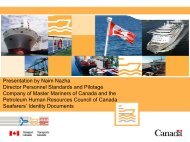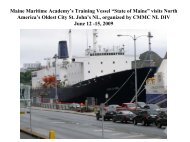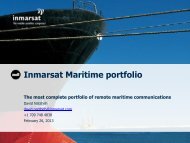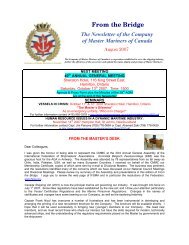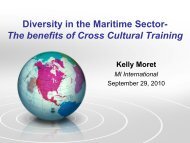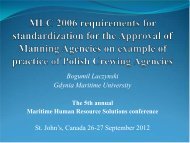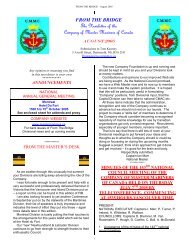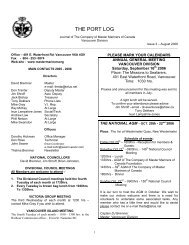From the Bridge - Company of Master Mariners of Canada
From the Bridge - Company of Master Mariners of Canada
From the Bridge - Company of Master Mariners of Canada
Create successful ePaper yourself
Turn your PDF publications into a flip-book with our unique Google optimized e-Paper software.
“<strong>From</strong> <strong>the</strong> <strong>Bridge</strong>” August 2009 www.mastermariners.ca<br />
"He kind <strong>of</strong> looked up at us for 10 to 15 seconds after we got it <strong>of</strong>f, and <strong>the</strong>n he was gone like a shot," he said. "We are<br />
so lucky." Not all whales are that lucky, and that's exactly why <strong>the</strong> Fisheries Department established <strong>the</strong> new marine<br />
mammal response network. "There are animals with gear on <strong>the</strong>m that you just can't get <strong>of</strong>f, and it's amazing how it just<br />
rubs through flesh and causes infection and problem for <strong>the</strong> animals." Cottrell said.<br />
He said entanglements, strandings and collisions involving whales have become much more common, and it's hoped <strong>the</strong><br />
network will be able to save more whales. The network encourages residents up and down <strong>the</strong> B.C. coast to report any<br />
dead or distressed animals so <strong>the</strong> ones that need rescuing can be helped and <strong>the</strong> dead ones can be studied.<br />
Of <strong>the</strong> 31 marine mammal species in B.C. waters, 13 are listed under <strong>the</strong> Species at Risk Act as endangered, threatened<br />
or <strong>of</strong> special concern. Cottrell and o<strong>the</strong>r DFO <strong>of</strong>ficials happened to be in <strong>the</strong> area on Monday monitoring whale activity<br />
around <strong>the</strong> Robson Bight killer whale reserve.<br />
Salvage crews were doing a delicate operation attempting to lift vehicles and o<strong>the</strong>r logging equipment from a barge that<br />
sank in August 2007. The barge was carrying a container with 1,400 litres <strong>of</strong> hydraulic oil and a tanker truck loaded with<br />
10,000 litres <strong>of</strong> diesel fuel. Both <strong>the</strong> oil and <strong>the</strong> tanker truck have been recovered without incident.<br />
The bight is well known as <strong>the</strong> area where killer whales rub <strong>the</strong>ir bodies on <strong>the</strong> rocks along <strong>the</strong> beach. A spill could have<br />
been an environmental disaster for marine mammals <strong>the</strong>re.<br />
The public can report dead or injured animals by calling <strong>the</strong> DFO’s toll-free Observe Record Report hotline at:<br />
1-800-465-4336. http://www.cbc.ca/canada/british-columbia/story/2009/05/19/bc-entangled-whale-rescued.html<br />
Note: Captain Edward Dahlgren <strong>of</strong> CCG was <strong>the</strong> Captain <strong>of</strong> <strong>the</strong> ship used for <strong>the</strong> whale rescue and <strong>the</strong> salvage<br />
operation. Captain Dahlgren is a Vancouver Division member.<br />
Picture provided by BC Ferries.<br />
The Nor<strong>the</strong>rn Expedition, which arrived in<br />
April from <strong>the</strong> shipyard in Germany where she<br />
was built, and <strong>the</strong> Nor<strong>the</strong>rn Adventure are now<br />
serving <strong>the</strong> Port Hardy-Prince Rupert and<br />
Skidegate-Prince Rupert routes respectively.<br />
Being de-commissioned is <strong>the</strong> Queen <strong>of</strong><br />
Prince Rupert which has served <strong>the</strong> coastal<br />
communities <strong>of</strong> nor<strong>the</strong>rn British Colombia for<br />
43 years. The picture shows <strong>the</strong> Nor<strong>the</strong>rn<br />
Expedition, Nor<strong>the</strong>rn Adventure and Queen <strong>of</strong><br />
Prince Rupert toge<strong>the</strong>r for <strong>the</strong> first and only<br />
time. The Queen <strong>of</strong> Prince Rupert, which is<br />
now for sale, was launched at <strong>the</strong> Victoria<br />
Machinery Depot in Victoria BC in 1965 and<br />
made her first run to Prince Rupert on May<br />
20 th 1966.<br />
The Arctic: US and <strong>Canada</strong> team for Arctic survey. The US and Canadian governments have released details<br />
<strong>of</strong> a planned 42-day Arctic Ocean mapping mission as part <strong>of</strong> <strong>the</strong> two countries' efforts to extend <strong>the</strong>ir sovereignty over<br />
resource-rich areas <strong>of</strong> <strong>the</strong> polar seabed. The scheduled survey <strong>of</strong> a subsea mountain range in waters far to <strong>the</strong> north <strong>of</strong><br />
<strong>the</strong> Alaska-Yukon border, to be carried out jointly with scientists from <strong>the</strong> US and <strong>Canada</strong>, follows a similar collaborative<br />
research expedition last summer in <strong>the</strong> Beaufort Sea.<br />
As <strong>the</strong>y did last year, <strong>the</strong> US Coast Guard cutter Healy and <strong>the</strong> Canadian Coast Guard icebreaker Louis S St-Laurent will<br />
rendezvous in <strong>the</strong> ocean west <strong>of</strong> <strong>the</strong> Canadian Arctic archipelago to begin carrying out <strong>the</strong> survey on 6 August,<br />
according to a Canwest News Service report.<br />
Last summer's mapping mission was considered a major success, partly because an unprecedented retreat <strong>of</strong> sea ice<br />
from <strong>the</strong> Beaufort left scientists a clear path to quickly and thoroughly survey a wide swath <strong>of</strong> <strong>the</strong> ocean. Officials said at<br />
<strong>the</strong> time that <strong>the</strong> sharing <strong>of</strong> specialised surveying equipment and o<strong>the</strong>r resources also allowed each country to map a<br />
much greater area <strong>of</strong> <strong>the</strong> sea floor than if <strong>the</strong>y'd been working independently.<br />
All five nations with an Arctic Ocean coastline — <strong>Canada</strong>, <strong>the</strong> US, Denmark (Greenland), Norway and Russia — are<br />
working under provisions <strong>of</strong> a United Nations treaty to gain control <strong>of</strong> subsea territory.<br />
The challenge is to identify — through sonar surveys <strong>of</strong> <strong>the</strong> ocean floor and o<strong>the</strong>r geological evidence — areas <strong>of</strong> <strong>the</strong><br />
seabed that are linked to each country's continental shelf.<br />
Norway has already been granted sovereignty over several large tracts <strong>of</strong> Arctic and North Atlantic seabed under <strong>the</strong> UN<br />
Convention on <strong>the</strong> Law <strong>of</strong> <strong>the</strong> Sea. The Norwegian government has also announced it will make no claim to areas in <strong>the</strong><br />
deeper Arctic Ocean near <strong>the</strong> North Pole, conceding that <strong>Canada</strong>, Russia and Denmark have stronger cases for<br />
asserting sovereignty along <strong>the</strong> potentially oil-rich Lomonosov, Alpha and Mendeleev subsea mountain ridges.<br />
http://www.upstreamonline.com/live/article184033.ece<br />
8



